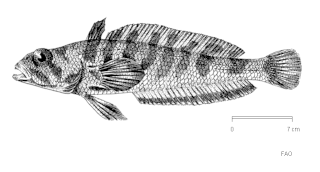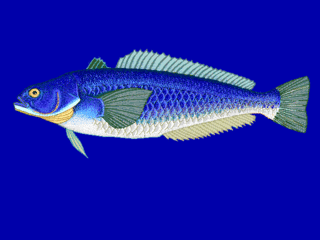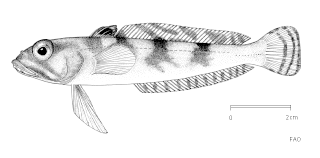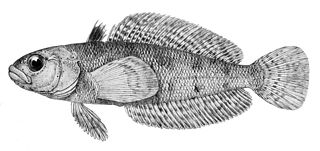
Notothenia angustata, the Maori chief or black cod, is a species of marine ray-finned fish, belonging to the family Nototheniidae, the notothens or cod icefishes. It is native to the Southern Ocean

Nototheniidae, the notothens or cod icefishes, is a family of ray-finned fishes, part of the suborder Notothenioidei which is traditionally placed within the order Perciformes. They are largely found in the Southern Ocean.

The Antarctic silverfish, or Antarctic herring, is a species of marine ray-finned fish belonging to the family Nototheniidae, the notothens or cod icefishes. It is native to the Southern Ocean and the only truly pelagic fish in the waters near Antarctica. It is a keystone species in the ecosystem of the Southern Ocean.

Notothenia is a genus of marine ray-finned fishes belonging to the family Nototheniidae, the notothens or cod icefishes with the species in this genus often having the common name of rockcod. They are native to the Southern Ocean and other waters around Antarctica.

The painted notie, or painted notothen, is a species of marine ray-finned fish, belonging to the family Nototheniidae, the notothens or cod icefishes. It is native to the Southern Ocean.

Paranotothenia magellanica, also known as Magellanic rockcod, Maori cod, blue notothenia or orange throat notothen, is a species of marine ray-finned fish, belonging to the family Nototheniidae, the notothens or cod icefishes. It is native to the Southern Ocean. "Maori chief" and "black cod", sometimes used for this species, usually refer to fishes from the related genus Notothenia. Being a perciform fish, it is unrelated to the true cods of the order Gadiformes. This species is commercially important as a food fish.

Pagothenia is a genus of marine ray-finned fishes, belonging to the family Nototheniidae, the notothens or cod icefishes. These fishes occur in the Southern Ocean.

The ploughfish is a species of Antarctic dragonfish native to the Southern Ocean around Antarctica. It is found at depths of from 0 to 550 m over the Antarctic continental shelf. This species is the only known member of its genus.

The emerald rockcod, also known as the emerald notothen is a species of marine ray-finned fish belonging to the family Nototheniidae, the notothens or cod icefishes. It is native to the Southern Ocean where it is a commercially important species.

The longfin icedevil, also known as the threadfin pinhead, is a species of marine ray-finned fish belonging to the family Nototheniidae, the notothens or cod icefishes. It is native to the Southern Ocean where it can be found at depths down to 850 metres (2,790 ft). This species grows to a length of 42 centimetres (17 in) TL. This species is the only known member of its genus and is of no interest to commercial fisheries.
Cryothenia is a genus of marine ray-finned fishes, belonging to the family Nototheniidae, the notothens or cod icefishes. They are native to the Southern Ocean.

Gobionotothen is a genus of marine ray-finned fishes belonging to the family Nototheniidae, the notothens or cod icefishes. They are native to the Southern Ocean.

The grey rockcod, also known as the grey notothen, stripe-eyes notothen or stripe-eyed rockcod, is a species of marine ray-finned fish belonging to the family Nototheniidae, the notothens or cod icefishes. It is native to the Southern Ocean. The grey rockcod feeds mainly on macrozooplankton and is of minor importance to commercial fisheries. It is the only species in the genus Lepidonotothen.

Paranotothenia is a genus of marine ray-finned fishes belonging to the family Nototheniidae, the notothens or cod icefishes. These fishes are native to the Southern Ocean.

Lindbergichthys nudifrons, the yellowfin rockcod, also known as the yellow notie or the gaudy notothen, is a species of marine ray-finned fish, belonging to the family Nototheniidae, the notothens or cod icefishes. It is native to the Atlantic sector of the Southern Ocean.

Gvozdarus svetovidovi, the naked-head toothfish, is a species of marine ray-finned fish belonging to the family Nototheniidae, the notothens or cod icefishes. It is found in the Ross and Cooperation Seas, probably south of the Antarctic Polar Front from pelagic waters down to depths of 550 m (1,804 ft), though it is normally found in a pelagic environment.

Gobionotothen gibberifrons, the humped rockcod or the humphead notothen, is a species of marine ray-finned fish belonging to the family Nototheniidae, the notothens or cod icefishes. It is native to the islands of the Scotia Arc, the northern part of the Antarctic Peninsula, and Heard Island in the Southern Ocean. This species inhabits depths of 6-429 m, but is most abundant at depths of 100-400 m, at least around Elephant Island.

Gobionotothen marionensis, the lobe-lip notothen, is a species of marine ray-finned fish belonging to the family Nototheniidae, the notothens or cod icefishes. It is native to the South Georgia and the South Sandwich Islands in the Atlantic Ocean, and the Crozet and Prince Edward Islands in the Indian Ocean.>
Gobionotothen acuta, the triangular rockcod or the triangular notothen, is a species of marine ray-finned fish belonging to the family Nototheniidae, the notothens or cod icefishes. It is native to the French Southern and Antarctic Lands, the Heard Islands and the Kerguelen Plateau in the Southern Ocean.

The stocky rockcod, also known as the bandtail notothen, is a species of marine ray-finned fish belonging to the family Nototheniidae, the notothens or cod icefishes. It is found in the Southern Ocean.
















